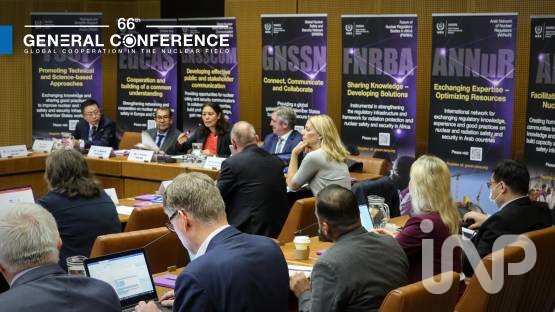
International efforts to strengthen nuclear safety and security, as well as ways of promoting IAEA legal instruments, capacity building and eLearning initiatives in this field, were among the main topics discussed during the Ninth Global Nuclear Safety and Security Network (GNSSN) Plenary Meeting, held on the sidelines of the IAEA’s 66th General Conference today.
The GNSSN is a knowledge network for capacity-building and enhancing international cooperation and dialogue in the nuclear safety and security field. It also harmonizes national approaches to nuclear safety knowledge management.
“I would like to emphasize the role of GNSSN to support and coordinate the regional and inter-regional efforts for the sharing of knowledge, expertise and experience on safety-relevant issues and take this opportunity to encourage the Member States to actively participate in the GNSSN for efficient information sharing and effective cooperation,” said Alfredo de los Reyes Castelo, Head of International Relations at the Spanish Nuclear Safety Council (CSN) and Chair of the GNSSN’s Steering Committee.
At this year’s meeting, over 100 participants were given an overview of IAEA international legal instruments, such as the Joint Convention on the Safety of Spent Fuel Management and on the Safety of Radioactive Waste Management, the Convention on Nuclear Safety and the Convention on the Physical Protection of Nuclear Material and its Amendment, which are the cornerstones of the global nuclear safety and security architecture and provide for the establishment of robust nuclear safety and security frameworks. The IAEA’s safety standards, security guidance and services play a central role in facilitating countries’ implementation of these instruments.
In his remarks, Wolfram Tonhauser, IAEA Section Head of Nuclear and Treaty Law highlighted the comprehensive assistance available to support Member States in adhering to the various international legal instruments adopted under IAEA auspices and in developing corresponding national nuclear legislation. He emphasized the importance of the GNSSN in raising awareness about these instruments and in highlighting the services at the disposal of Member States under the Agency’s Legislative Assistance programme.
Delegates also discussed the IAEA’s role in nuclear safety and security at the nuclear facilities within Ukraine. Frederic Stephani, IAEA Emergency Preparedness Officer, provided a presentation on the Agency’s Incident and Emergency Centre response to the Ukraine situation, highlighting the Director General’s updates, which provide regular information on the safety and security status at nuclear installations in the country.
Svetlana Nestoroska-Madjunarova, Coordinator for Assistance to Ukraine in Nuclear Safety and Security, delivered a presentation on the scope of the IAEA’s assistance to Ukraine, including the delivery status and major accomplishments arising from recent activities and missions.
“Over the past 15 years, GNSSN has been continuously supporting implementation of the IAEA integrated methodology for capacity building and has significantly contributed to enhancing international cooperation and dialogue in the field of nuclear safety and security,” said Lydie Evrard, IAEA Deputy Director General and Head of the Department of Nuclear Safety and Security.
A further area of discussion was on safety and security issues relating to the deployment of advanced nuclear power reactors, such as small modular reactors (SMRs). With more than 80 SMR designs under development in 19 countries and the first SMR units already in operation in China and Russia, many countries are considering the introduction or the deployment of such technology. The IAEA has developed tools and platforms to provide information and assist countries to implement safety and security requirements and recommendations.
Anna Bradford, Director of the IAEA’s Division of Nuclear Installation Safety, highlighted the challenges and opportunities presented by innovative reactors, such as SMRs, and explained what the Agency is doing to address the unique safety and security issues. She drew attention to the Nuclear Harmonization and Standardization Initiative (NHSI), an initiative the IAEA Director General announced in March this year, as well as the Agency-wide platform on SMRs and the SMR Regulators’ Forum, in which national regulators can discuss approaches to this new technology.
Meeting participants were also informed that the IAEA has launched new eLearning initiatives to support countries with their human resource development to ensure a better understanding of the Agency’s safety requirements and security recommendations. The initiatives aim to complement instructor led courses or provide a foundation for other IAEA specialized courses. “The Global Nuclear Safety and Security Network plays a fundamental role in informing, engaging and supporting individuals and organizations with accessing these services,” said Dominique Delattre, Head of the Safety Standards and Security Guidance Development Section at the IAEA.

